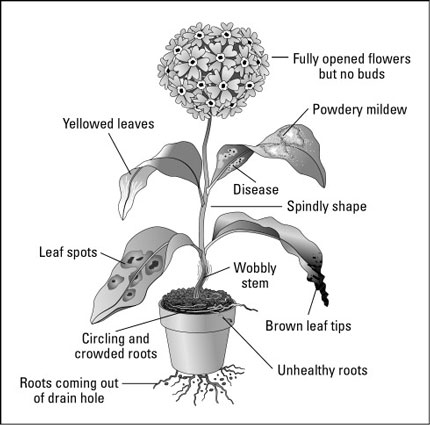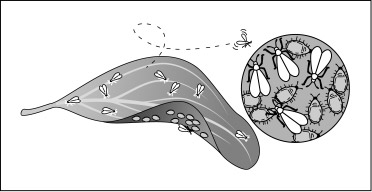Always give a plant a quick once-over, at the very least, before you make the purchase no matter where you're buying the plant. The following list tells you about the major signs of distress and disease in a plant (and you can follow along with Figure 1):
 |
Figure 1: Trouble signs to watch for when shopping for plants. |
- Wobbly plants: Give the plant a quick shake. A plant that's unsteady in its pot may not be well-rooted. Shaking the plant also tells you whether the plant has whiteflies (see Figure 2) because the flies, which resemble dandruff, take off like a shot when you move the plant.
 |
Figure 2: Whiteflies. |
- Crowded roots: Check the bottom of the pot for roots coming out of the drainage hole. Roots emerging from holes in the pot don't necessarily mean that the plant is underpotted, but it's frequently a first symptom. If in doubt, ask the clerk to remove the pot (if possible) so that you can see the roots. (Expect this kind of service only in a nursery, garden center, or florist shop.) If roots are wound around the base of the plant, you know it's underpotted and possibly stressed. Try to find another plant of the same kind that has a less-developed root ball. A healthy root ball holds together but doesn't have excess roots showing when you remove it from the pot.
- Unhealthy roots: If you've convinced the clerk to remove the pot to let you check for crowded roots, go ahead and check the plant's overall health as well. Roots come in all sizes, shapes, and colors, but they should always feel firm, not squishy, with the tips a paler color than the rest of the roots. Examine bits of white fluff among the roots with suspicion: You're quite possibly face to face with soil mealybugs. On the other hand, that white fluff may be nothing more than bits of perlite, a common medium for potting plants. A soggy growing medium also means bad news.
- Signs of rot: Sniff the potting mix. If it has a forest-after-a-spring-rain smell, all is well. If it has the sickly sweet smell of a rotting potato, put the plant down — more than likely, that plant has a bad case of root rot or stem rot.
- Leaf spots: Leaf spots can indicate disease. Physical damage can generate leaf spots, too (garden center plants tend to get jostled around a bit). Damaged leaves never recover, however. Ask yourself whether you're willing to wait for the plant to produce new leaves. You may decide you prefer a healthier specimen.
- Spindly, leggy plants or ones with brown leaf tips: These symptoms indicate the plant has not been getting adequate care for quite some time.
- Signs of insects or disease: Make sure to look underneath the leaves and at the leaf axils (the point where the leaf meets the stem), two places where most pests hang out.
- Yellowed leaves or abundant leaf loss: A yellow leaf or two at the base of a plant is nothing to be alarmed about. If you see many yellow or fallen leaves, however, the plant's probably stressed and therefore not a good choice.
- Lots of open flowers, but only a few unopened buds: A flowering plant in full bloom can look spectacular but may be well past its prime and ready to stop blooming in short order. Buy a plant mostly in bud with just enough open blooms to let you see its eventual color. Then you know that you've yet to see the plant at its best.
Chrysanthemums and miniature roses are exceptions to the avoid-lots-of-opened-flowers rule: Chrysanthemum and rose buds not fully open may not open at all under home growing conditions unless you can give them full sun. Buy chrysanthemums and miniature roses already at their peak of bloom.






